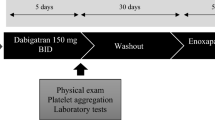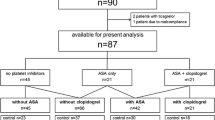Abstract
The new oral anticoagulants (NOACs) reduce stroke and systemic embolism in patients with non-valvular atrial fibrillation (AF), but dabigatran may increase risk of coronary ischemic events for unclear reasons. Thus, this study assessed the effects of dabigatran and rivaroxaban on platelet reactivity and inflammatory markers in patients with non-valvular AF. Patients with non-valvular AF planned to begin treatment with NOACs were included. Seventeen patients were prescribed dabigatran and ten rivaroxaban. Platelet function (as assessed by multiple-electrode aggregometry, Impact-R shear-induced platelet deposition, P-selectin expression and plasma RANTES levels) and high-sensitivity C-reactive protein (hs-CRP) were measured at enrollment (prior to initiation of NOAC treatment) and at least 7 days into treatment with either dabigratran or rivaroxaban. Seventeen patients treated with dabigatran (mean age 69 ± 7 years, 35 % women, mean CHADS2 score 2.6 ± 1.2), and ten patients treated with rivaroxaban (mean age 73 ± 9 years, 20 % women, mean CHADS2 score 2.7 ± 1.6) completed the study. In both groups, there were no significant differences in platelet reactivity between the baseline and on-anticoagulant treatment time-points, as measured by each of the platelet-specific assays. There was a trend towards increased platelet reactivity in response to arachidonic acid from baseline to on-treatment in both groups, probably as a result of aspirin discontinuation in 33 % of patients. No significant differences were noted between baseline and on-treatment in hs-CRP in both anticoagulant groups. Treatment with dabigatran and rivaroxaban does not appear to be associated with changes in markers of platelet reactivity or systemic inflammation.

Similar content being viewed by others
References
Camm AJ, Kirchhof P, Lip GY et al (2010) Guidelines for the management of atrial fibrillation: the Task Force for the Management of Atrial Fibrillation of the European Society of Cardiology (ESC). Eur Heart J 31:2369–2429
Fuster V, Ryden LE, Cannom DS et al (2011) 2011 ACCF/AHA/HRS focused updates incorporated into the ACC/AHA/ESC 2006 guidelines for the management of patients with atrial fibrillation: a report of the American College of Cardiology Foundation/American Heart Association Task Force on practice guidelines. Circulation 123:e269–e367
Benjamin EJ, Wolf PA, D’Agostino RB, Silbershatz H, Kannel WB, Levy D (1998) Impact of atrial fibrillation on the risk of death: the Framingham Heart Study. Circulation 98:946–952
Dries DL, Exner DV, Gersh BJ, Domanski MJ, Waclawiw MA, Stevenson LW (1998) Atrial fibrillation is associated with an increased risk for mortality and heart failure progression in patients with asymptomatic and symptomatic left ventricular systolic dysfunction: a retrospective analysis of the SOLVD trials. Studies of Left Ventricular Dysfunction. J Am Coll Cardiol 32:695–703
Friberg J, Scharling H, Gadsboll N, Truelsen T, Jensen GB (2004) Comparison of the impact of atrial fibrillation on the risk of stroke and cardiovascular death in women versus men (The Copenhagen City Heart Study). Am J Cardiol 94:889–894
Frost L, Andersen LV, Vestergaard P, Husted S, Mortensen LS (2007) Trend in mortality after stroke with atrial fibrillation. Am J Med 120:47–53
Genovesi S, Vincenti A, Rossi E et al (2008) Atrial fibrillation and morbidity and mortality in a cohort of long-term hemodialysis patients. Am J Kidney Dis 51:255–262
Krahn AD, Manfreda J, Tate RB, Mathewson FA, Cuddy TE (1995) The natural history of atrial fibrillation: incidence, risk factors, and prognosis in the Manitoba Follow-Up Study. Am J Med 98:476–484
Wolf PA, Abbott RD, Kannel WB (1991) Atrial fibrillation as an independent risk factor for stroke: the Framingham Study. Stroke 22:983–988
Andersen LV, Vestergaard P, Deichgraeber P, Lindholt JS, Mortensen LS, Frost L (2008) Warfarin for the prevention of systemic embolism in patients with non-valvular atrial fibrillation: a meta-analysis. Heart 94:1607–1613
Mant J, Hobbs FD, Fletcher K et al (2007) Warfarin versus aspirin for stroke prevention in an elderly community population with atrial fibrillation (the Birmingham Atrial Fibrillation Treatment of the Aged Study, BAFTA): a randomised controlled trial. Lancet 11(370):493–503
Go AS, Hylek EM, Borowsky LH, Phillips KA, Selby JV, Singer DE (1999) Warfarin use among ambulatory patients with nonvalvular atrial fibrillation: the anticoagulation and risk factors in atrial fibrillation (ATRIA) study. Ann Intern Med 131:927–934
(1998) Patients with nonvalvular atrial fibrillation at low risk of stroke during treatment with aspirin: Stroke Prevention in Atrial Fibrillation III Study. The SPAF III Writing Committee for the Stroke Prevention in Atrial Fibrillation Investigators. JAMA 279:1273–1277
(1994) Warfarin versus aspirin for prevention of thromboembolism in atrial fibrillation: Stroke Prevention in Atrial Fibrillation II Study. Lancet 343:687–691
Ezekowitz MD, Bridgers SL, James KE et al (1992) Warfarin in the prevention of stroke associated with nonrheumatic atrial fibrillation. Veterans Affairs Stroke Prevention in Nonrheumatic Atrial Fibrillation Investigators. N Engl J Med 327:1406–1412
(1990) Preliminary report of the Stroke Prevention in Atrial Fibrillation Study. N Engl J Med 322:863–868
Connolly SJ, Ezekowitz MD, Yusuf S et al (2009) Dabigatran versus warfarin in patients with atrial fibrillation. N Engl J Med 361:1139–1151
Patel MR, Mahaffey KW, Garg J et al (2011) Rivaroxaban versus warfarin in nonvalvular atrial fibrillation. N Engl J Med 365:883–891
Granger CB, Alexander JH, McMurray JJ et al (2011) Apixaban versus warfarin in patients with atrial fibrillation. N Engl J Med 365:981–992
Uchino K, Hernandez AV (2012) Dabigatran association with higher risk of acute coronary events: meta-analysis of noninferiority randomized controlled trials. Arch Intern Med 172:397–402
Mega JL, Braunwald E, Wiviott SD et al (2012) Rivaroxaban in patients with a recent acute coronary syndrome. N Engl J Med 366:9–19
Christersson C, Johnell M, Siegbahn A (2010) The influence of direct thrombin inhibitors on the formation of platelet-leukocyte aggregates and tissue factor expression. Thromb Res 126:e327–e333
Christersson C, Oldgren J, Wallentin L, Siegbahn A (2011) Treatment with an oral direct thrombin inhibitor decreases platelet activity but increases markers of inflammation in patients with myocardial infarction. J Intern Med 270:215–223
Sibbing D, Braun S, Morath T et al (2009) Platelet reactivity after clopidogrel treatment assessed with point-of-care analysis and early drug-eluting stent thrombosis. J Am Coll Cardiol 53:849–856
Shenkman B, Savion N, Dardik R, Tamarin I, Varon D (2000) Testing of platelet deposition on polystyrene surface under flow conditions by the cone and plate(let) analyzer: role of platelet activation, fibrinogen and von Willebrand factor. Thromb Res 99:353–361
Li Z, Delaney MK, O’Brien KA, Du X (2010) Signaling during platelet adhesion and activation. Arterioscler Thromb Vasc Biol 30:2341–2349
Aggarwal A, Sobel BE, Schneider DJ (2002) Decreased platelet reactivity in blood anticoagulated with bivalirudin or enoxaparin compared with unfractionated heparin: implications for coronary intervention. J Thromb Thrombolysis 13:161–165
Keating FK, Dauerman HL, Whitaker DA, Sobel BE, Schneider DJ (2006) Increased expression of platelet P-selectin and formation of platelet-leukocyte aggregates in blood from patients treated with unfractionated heparin plus eptifibatide compared with bivalirudin. Thromb Res 118:361–369
Lev EI, Patel R, Karim A, Kleiman A, Badimon JJ, Kleiman NS (2006) Anti-thrombotic effect of bivalirudin compared with eptifibatide and unfractionated heparin in diabetic patients: an ex vivo human study. Thromb Haemost 95:441–446
Wolzt M, Bostrom SL, Svensson M, Wahlander K, Grind M, Sarich TC (2003) Effects of the oral direct thrombin inhibitor ximelagatran on p-selectin expression and thrombin generation in atrial fibrillation. Pathophysiol Haemost Thromb 33:68–74
Weitz JI, Hudoba M, Massel D et al (1990) Clot-bound thrombin is protected frominhibition by heparin-antithrombin III but is susceptible to inactivation byantithrombin III-independent inhibitors. J Clin Invest 86:385–391
Farivar AS, Delgado MF, McCourtie AS et al (2006) Crosstalk between thrombosisand inflammation in lung reperfusion injury. Ann Thorac Surg 81:1061–1067
Erlich JH, Boyle EM, Labriola J et al (2000) Inhibition of the tissue factor-thrombinpathway limits infarct size after myocardial ischemia-reperfusion injury byreducing inflammation. Am J Pathol 157:1849–1862
Chen B, Cheng Q, Yang K et al (2010) Thrombin mediates severe neurovascularinjury during ischemia. Stroke 41:2348–2352
Mattsson C, Sarich TC, Carlsson SC (2005) Mechanism of action of the oral directthrombin inhibitor ximelagatran. Semin Vasc Med 5:235–244
Marty I, Peclat V, Kirdaite G et al (2001) Amelioration of collagen-induced arthritis bythrombin inhibition. J Clin Invest 107:631–640
Renda G, Malatesta G, Bucciarelli V, et al. Differential effects of the direct thrombin inhibitor dabigatran etexilate vs warfarin on platelet function. http://spo.escardio.org/eslides/view.aspx?eevtid=54&fp=5292
Author information
Authors and Affiliations
Corresponding author
Ethics declarations
Conflict of interest
The authors declare that they have no conflict of interest.
Financial support
Rabin Medical Center.
Rights and permissions
About this article
Cite this article
Zemer-Wassercug, N., Haim, M., Leshem-Lev, D. et al. The effect of dabigatran and rivaroxaban on platelet reactivity and inflammatory markers. J Thromb Thrombolysis 40, 340–346 (2015). https://doi.org/10.1007/s11239-015-1245-z
Published:
Issue Date:
DOI: https://doi.org/10.1007/s11239-015-1245-z




